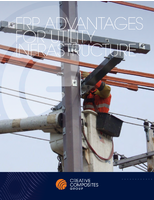Siemens Hands Over World's Largest Offshore Grid Connection to TenneT
Share:
• SylWin1 grid connection with a record-setting capacity of 864 megawatts
• Transmission capacity enough to supply more than 1 million households
• All three connected wind farms equipped with Siemens wind turbines
• Third Siemens direct-current grid connection now in commercial operation
• German energy transition at sea heading toward the finish line
Siemens has handed over SylWin1, the third North Sea grid connection this year, to its customer TenneT. The German-Dutch transmission grid operator has now put the world's most powerful grid connection to date into commercial operation. The offshore platform of the SylWin1 grid connection is located around 70 kilometers west of the island of Sylt, after which the project was named. The electricity generated by wind power is transmitted over a more than 200 km subsea and underground cable link to the land-based station Büttel. Up to 864 megawatts (MW) of green electricity can now be transmitted with this grid connection - enough to supply more than a million German households.
"This year we have completed the world's first three offshore grid connections with efficient direct-current technology - SylWin1, BorWin2 and HelWin1. We also intend to put the fourth project HelWin2 into commercial operation as planned in the coming weeks", stated Jan Mrosik, CEO of the Siemens Energy Management Division. "2015 is a special milestone year for TenneT", emphasized Lex Hartman, member of the managing board of TenneT TSO GmbH, "as we will be completing further offshore grid connections by the end of the year, meaning that all in all we will have implemented a capacity of more than 5,000 MW, or more than two-thirds of the offshore expansion goal set by the Federal German government by then." The government's offshore expansion goal aims at implementing 6,500 MW by 2020.
The three offshore wind farms DanTysk, Butendiek and Sandbank, each with a capacity of 288 MW, are linked to SylWin1. DanTysk and Butendiek both consist of 80 Siemens wind turbines, each rated at 3.6 megawatts. Sandbank will be realized with 72 Siemens wind turbines in the 4-megawatt class. At present, more than 100 wind turbines are already linked to the grid connection, with new turbines being connected almost on a daily basis. Under optimal wind conditions, such as those which the low-pressure storm front Niklas brought with it recently, a capacity of 350 MW was already transmitted via the SylWin1 grid link.
Transmission system operator TenneT contracted the consortium comprising Siemens and the Italian cable specialist Prysmian for the HelWin1 offshore grid connection early in 2011. The offshore platform was built by Nordic Yards in Germany. In total, Siemens has been awarded five North Sea grid connection projects by TenneT: HelWin1 (576 MW) and HelWin2 (690 MW) off of Helgoland, BorWin2 (800 MW) and BorWin3 (900 MW) off of Borkum and SylWin1 (864 MW) off of Sylt. Three of these, BorWin2, HelWin1 and SylWin1, have already taken up normal operation.
The fourth grid connection HelWin2 is scheduled to take up commercial operation in the first half of 2015 as well. Siemens received its latest order for a grid connection in the North Sea, BorWin3, in a consortium with Petrofac in the spring of 2014. Commissioning of this fifth grid connection from Siemens is scheduled for 2019. The grid connections implemented by Siemens for TenneT will have a total transmission capacity of more than 3.8 gigawatts (GW), providing electricity from offshore wind power to supply nearly five million households.
Thanks to the Siemens high-voltage direct-current (HVDC) technology, transmission losses for each grid connection, including cable losses, are less than four percent. This Siemens HVDC technology is installed on the offshore platforms and in the land-based converter stations. The wind-based electricity is transmitted as alternating current to the converter platform, transformed into direct current and fed to the mainland via a subsea cable. The land-based station converts the direct current back into alternating current and feeds the electricity into the extra-high voltage grid. HVDC is the only efficient transmission solution for cable lengths of more than 80 kilometers.
The HVDC Plus technology used by Siemens is less complex and extremely compact, making it predestined for use in sea-based applications. In contrast to classic HVDC technology used in a vast majority of land links, systems equipped with HVDC Plus feature self-stabilization. As fluctuations in the grid must always be reckoned with for wind-based power generation, grid stability and reliability is enhanced considerably through the use of the Siemens HVDC Plus technology.
Siemens hands over the third North Sea grid connection SylWin1 to TenneT
Electricity from the three wind farms Butendiek, DanTysk and Sandbank is transmitted to the mainland via the SylWin1 grid connection. Siemens installed the grid connection in high-efficiency DC technology for network operator TenneT. The combined total of 232 Siemens wind turbines linked to the grid connection will provide enough electricity to supply more than one million households in the future. From the platform, there are wind turbines in view as far as the eye can see.
German wind farms with HVDC grid connections
To reliably convey the power from offshore wind farms to the mainland over long distances, the German-Dutch grid operator TenneT counts on low-loss high-voltage direct current (HVDC) transmission. Siemens is implementing a total of five of the nine HVDC offshore grid connections in the North Sea ordered to date, and thereby helping to make Germany's energy transition a success.
HVDC grid connection links numerous wind farms to the mainland
High-voltage direct current (HVDC) technology enables the alternating current generated by the wind farms to be converted into low-loss direct current. First, a number of transformer platforms arranged around the wind farm transform the alternating current before it is converted into direct current on a HVDC platform. It is transported to land via a submarine cable and then converted back into alternating current for onward transmission. HVDC technology is usually used when transmission cable lengths reach 80 km and longer.
Contact for journalists
Trade press:
Sabrina Martin
Phone: +49 9131 18-7032; E-mail: sabrina.martin@siemens.com
Business press:
Stefan Wagner
Phone: +49 89 636 632041; E-mail: sw.wagner@siemens.com
Siemens AG (Berlin and Munich) is a global technology powerhouse that has stood for engineering excellence, innovation, quality, reliability and internationality for more than 165 years. The company is active in more than 200 countries, focusing on the areas of electrification, automation and digitalization. One of the world’s largest producers of energy-efficient, resource-saving technologies, Siemens is No. 1 in offshore wind turbine construction, a leading supplier of combined cycle turbines for power generation, a major provider of power transmission solutions and a pioneer in infrastructure solutions as well as automation, drive and software solutions for industry. The company is also a leading provider of medical imaging equipment - such as computed tomography and magnetic resonance imaging systems - and a leader in laboratory diagnostics as well as clinical IT. In fiscal 2014, which ended on September 30, 2014, Siemens generated revenue from continuing operations of €71.9 billion and net income of €5.5 billion. At the end of September 2014, the company had around 343,000 employees worldwide on a continuing basis. Further information is available on the Internet at www.siemens.com.
Siemens AG
Communications and Government Affairs
Head: Stephan Heimbach
Wittelsbacherplatz 2
80333 Munich
Germany




